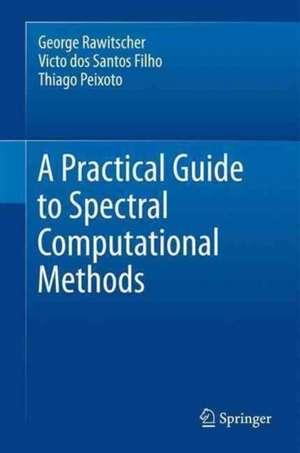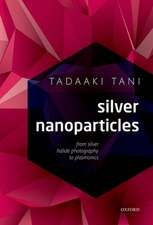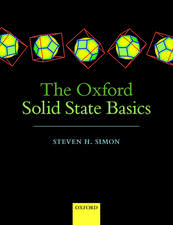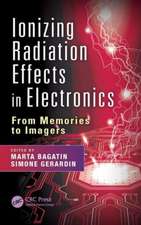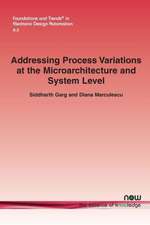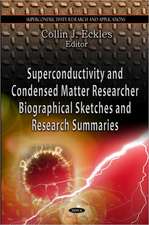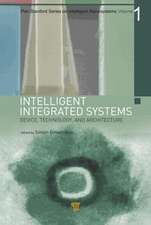An Introductory Guide to Computational Methods for the Solution of Physics Problems: With Emphasis on Spectral Methods
Autor George Rawitscher, Victo dos Santos Filho, Thiago Carvalho Peixotoen Limba Engleză Paperback – 25 oct 2018
This monograph presents fundamental aspects of modern spectral and other computational methods, which are not generally
taught in traditional courses. It emphasizes concepts as errors, convergence, stability, order and efficiency applied to
the solution of physical problems. The spectral methods consist in expanding the function to be calculated into a set of
appropriate basis functions (generally orthogonal polynomials) and the respective expansion coefficients are obtained via
collocation equations. The main advantage of these methods is that they simultaneously take into account all available
information, rather only the information available at a limited number of mesh points. They require more complicated
matrix equations than those obtained in finite difference methods. However, the elegance, speed, and accuracy of the
spectral methods more than compensates for anysuch drawbacks.
During the course of the monograph, the authors examine the usually rapid convergence of the spectral expansions and
the improved accuracy that results when nonequispaced support points are used, in contrast to the equispaced points
used in finite difference methods. In particular, they demonstrate the enhanced accuracy obtained in the solution
of integral equations.
The monograph includes an informative introduction to old and new computational methods with numerous practical examples,
while at the same time pointing out the errors that each of the available algorithms introduces into the specific
solution. It is a valuable resource for undergraduate students as an introduction to the field and for graduate students
wishing to compare the available computational methods. In addition, the work develops the criteria required for
students to select the most suitable method to solve the particular scientific problem that they are confronting.
Preț: 384.86 lei
Nou
Puncte Express: 577
Preț estimativ în valută:
73.64€ • 76.89$ • 60.81£
73.64€ • 76.89$ • 60.81£
Carte tipărită la comandă
Livrare economică 15-29 aprilie
Preluare comenzi: 021 569.72.76
Specificații
ISBN-13: 9783319427027
ISBN-10: 3319427024
Pagini: 206
Ilustrații: XVIII, 221 p. 109 illus., 108 illus. in color.
Dimensiuni: 155 x 235 mm
Greutate: 0.34 kg
Ediția:1st ed. 2018
Editura: Springer International Publishing
Colecția Springer
Locul publicării:Cham, Switzerland
ISBN-10: 3319427024
Pagini: 206
Ilustrații: XVIII, 221 p. 109 illus., 108 illus. in color.
Dimensiuni: 155 x 235 mm
Greutate: 0.34 kg
Ediția:1st ed. 2018
Editura: Springer International Publishing
Colecția Springer
Locul publicării:Cham, Switzerland
Cuprins
Dedication.- Preface.- Numerical Errors.- Methods.- Galerkin and Collocation Methods.- Convergence Theorems.- Chebyshev Polynomials.- The Integral Equation Corresponding to a Differential Equation.- Spectral Finite Element Method.- The Phase-Amplitude Representation of a Wave Function.- The Vibrating String.- Iteratively Calculated Eigenvalues.- Sturmian Functions.- Index.
Notă biografică
Born in Germany in 1928, George Rawitscher moved with his family to Sao Paulo, Brazil in 1934 in order to escape Nazi persecution. He studied Physics and Mathematics at the University of S. Paulo from 1945 to 1949, (with BA degrees), received his Ph.D. in Nuclear and Particle Physics in 1956 from Stanford University. After teaching at the University of Rochester and at Yale University, he went to the University of Connecticut in 1966 and rose to the rank of Full Professor in 1972. In 2009 he retired, and is now a Research Professor in UConn's physics department. His research specializations are in low energy nuclear physics and in computational methods. In addition to his continuing scientific physics involvements, his other interests are on World Order (UN transformation) and Climate Change.
Victo dos Santos Filho, born in 1967 in Lorena, São Paulo State, Brazil, studied Mathematics at the Universidade Salesiana de Lorena from 1985 to 1988, and in sequence he studied Physics at Universidade Estadual Paulista (UNESP) de Guaratinguetá from 1989 to 1992. He received his Master degree in Superconducting Technology in Fundação de Tecnologia Industrial (FTI) in 1994 and his Ph.D. in 2001 in Theoretical Physics at Instituto de Física Teórica (IFT) of UNESP, in the area of Bose-Einstein Condensates. After four years of post-doc in IFT concerning theoretical studies in Bose-Einstein Condensates with dissipative effects, he began to teach in private institutions of São Paulo. From 2015, he has worked in the H4D Scientific Laboratory Research as a scientific researcher in physics and technology. Among his recent scientific research interests are condensed matter physics, mathematical physics, general physics and computational physics.
Thiago Carvalho Peixoto graduated with a Bachelor degree in Physics in 2012 from the Federal University of Sergipe (UFS). He obtained a Master's Degree in Theoretical Physics in 2014 at the Theoretical Physics Institute of São Paulo's State University (UNESP). He worked as a professor of Physics at the Federal Institute of North of Minas Gerais (IFNMG) from 2016 to 2017 and nowadays he is professor of Physics at the Federal Institute of Sergipe (IFS).
Victo dos Santos Filho, born in 1967 in Lorena, São Paulo State, Brazil, studied Mathematics at the Universidade Salesiana de Lorena from 1985 to 1988, and in sequence he studied Physics at Universidade Estadual Paulista (UNESP) de Guaratinguetá from 1989 to 1992. He received his Master degree in Superconducting Technology in Fundação de Tecnologia Industrial (FTI) in 1994 and his Ph.D. in 2001 in Theoretical Physics at Instituto de Física Teórica (IFT) of UNESP, in the area of Bose-Einstein Condensates. After four years of post-doc in IFT concerning theoretical studies in Bose-Einstein Condensates with dissipative effects, he began to teach in private institutions of São Paulo. From 2015, he has worked in the H4D Scientific Laboratory Research as a scientific researcher in physics and technology. Among his recent scientific research interests are condensed matter physics, mathematical physics, general physics and computational physics.
Thiago Carvalho Peixoto graduated with a Bachelor degree in Physics in 2012 from the Federal University of Sergipe (UFS). He obtained a Master's Degree in Theoretical Physics in 2014 at the Theoretical Physics Institute of São Paulo's State University (UNESP). He worked as a professor of Physics at the Federal Institute of North of Minas Gerais (IFNMG) from 2016 to 2017 and nowadays he is professor of Physics at the Federal Institute of Sergipe (IFS).
Textul de pe ultima copertă
This monograph presents fundamental aspects of modern spectral and other computational methods, which are not generally
taught in traditional courses. It emphasizes concepts as errors, convergence, stability, order and efficiency applied to
the solution of physical problems. The spectral methods consist in expanding the function to be calculated into a set of
appropriate basis functions (generally orthogonal polynomials) and the respective expansion coefficients are obtained via
collocation equations. The main advantage of these methods is that they simultaneously take into account all available information, rather only the information available at a limited number of mesh points. They require more complicated
matrix equations than those obtained in finite difference methods. However, the elegance, speed, and accuracy of the
spectral methods more than compensates for anysuch drawbacks.
the improved accuracy that results when nonequispaced support points are used, in contrast to the equispaced points
used in finite difference methods. In particular, they demonstrate the enhanced accuracy obtained in the solution
of integral equations.
The monograph includes an informative introduction to old and new computational methods with numerous practical examples,
while at the same time pointing out the errors that each of the available algorithms introduces into the specific
solution. It is a valuable resource for undergraduate students as an introduction to the field and for graduate students
wishing to compare the available computational methods. In addition, the work develops the criteria required for
students to select the most suitable method to solve the particular scientific problem that they are confronting.
Caracteristici
Emphasizes some advantages of spectral methods Includes a comparison with finite element and finite difference methods Includes programs in MATLAB to implement the algorithms
